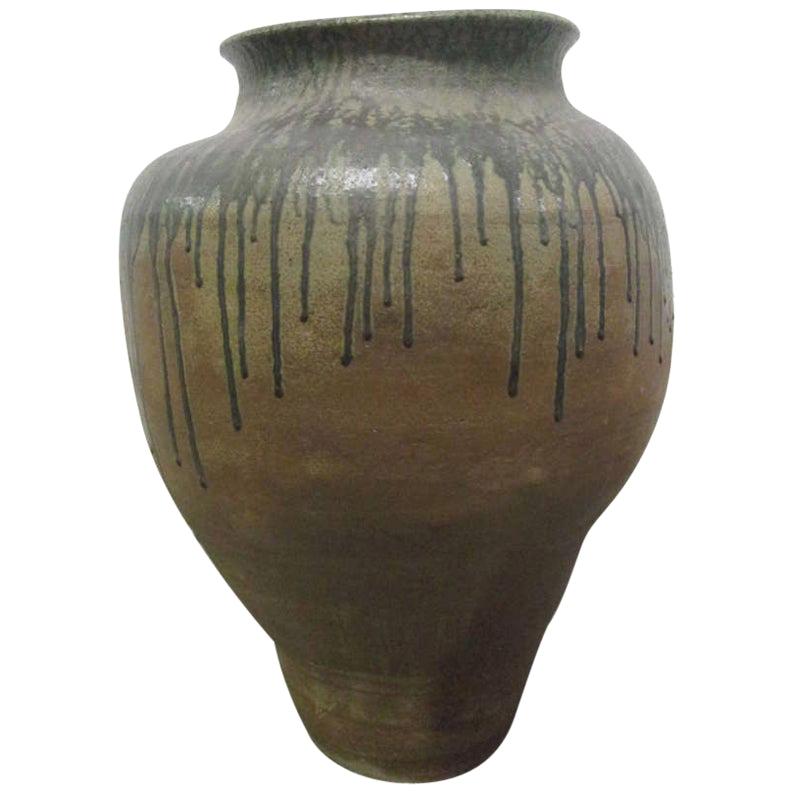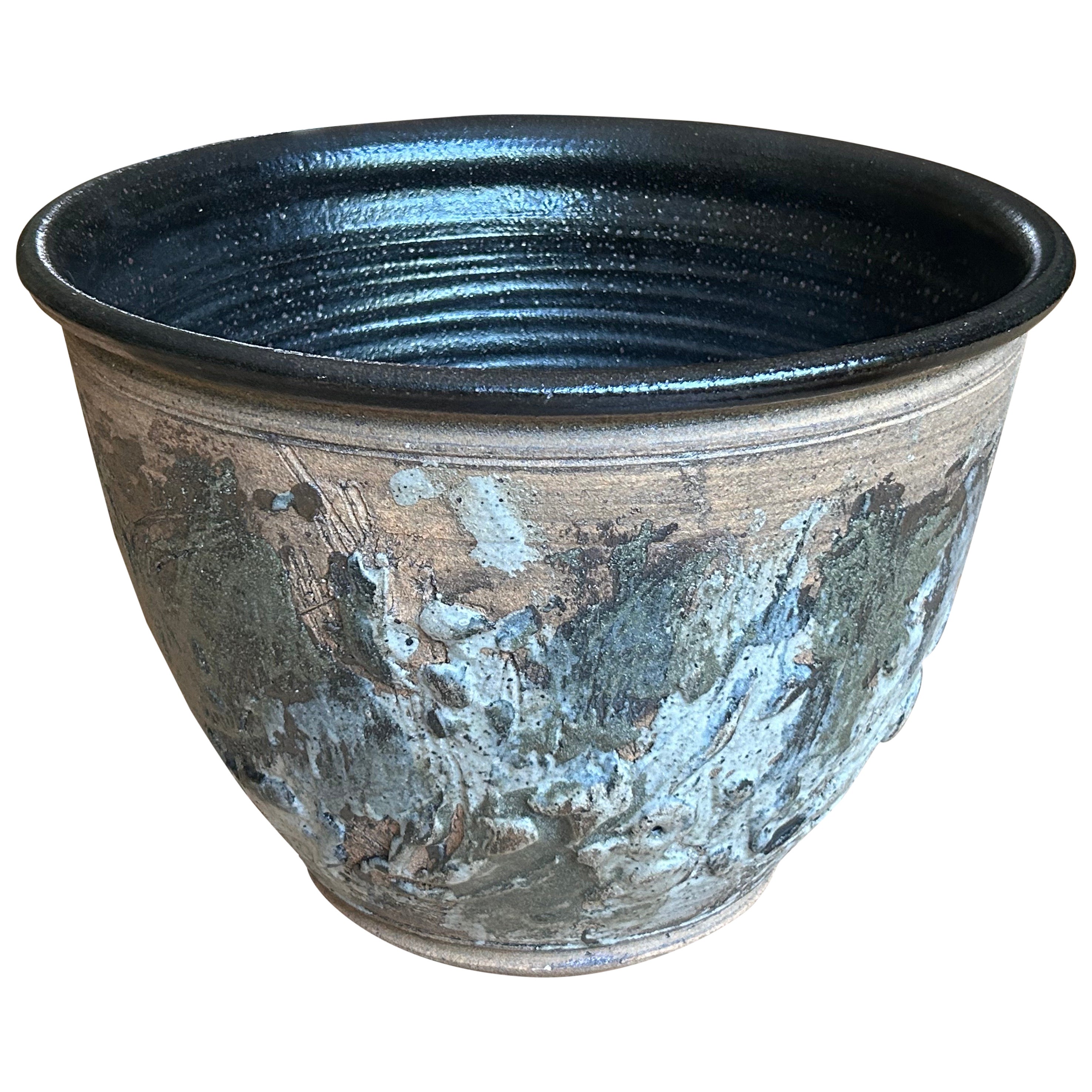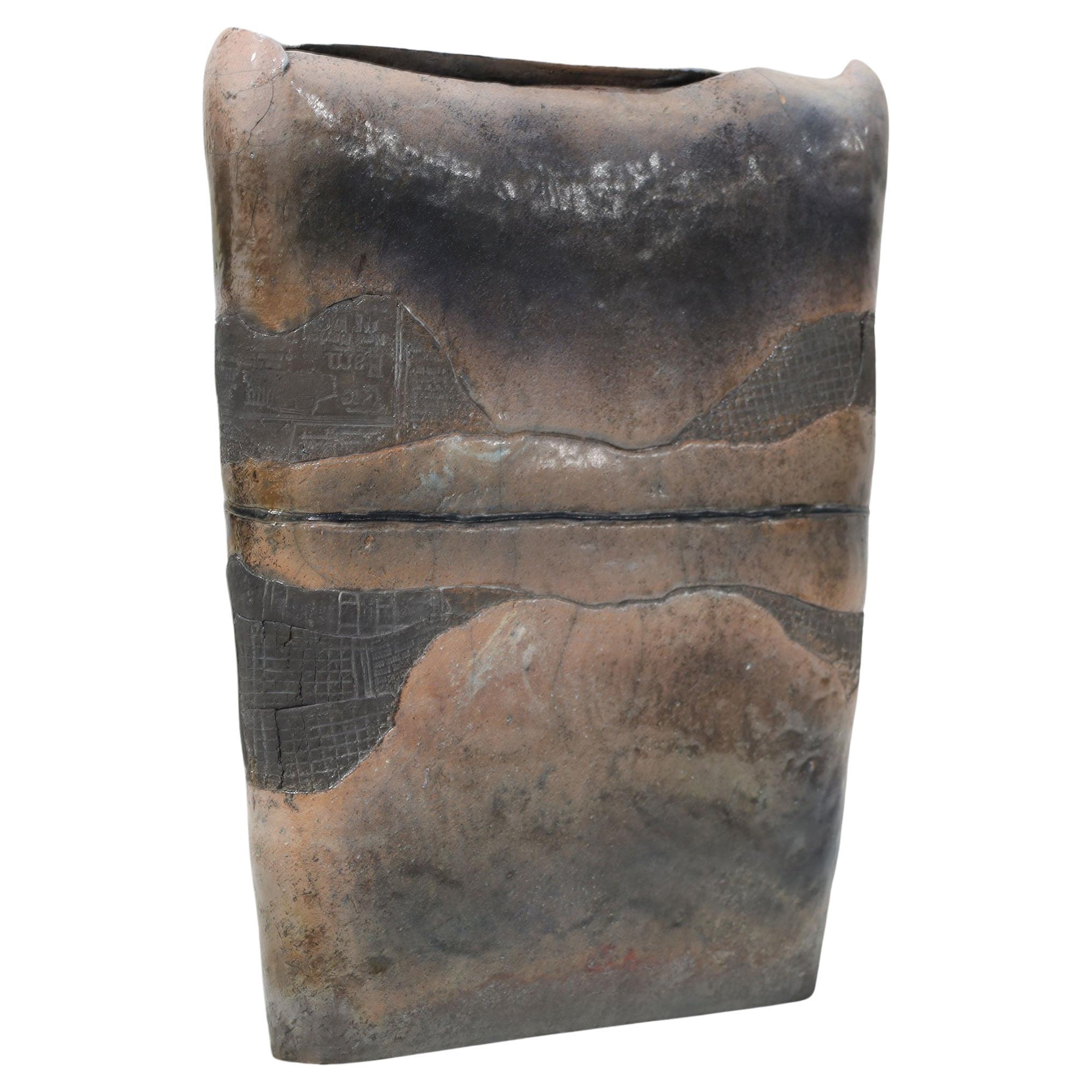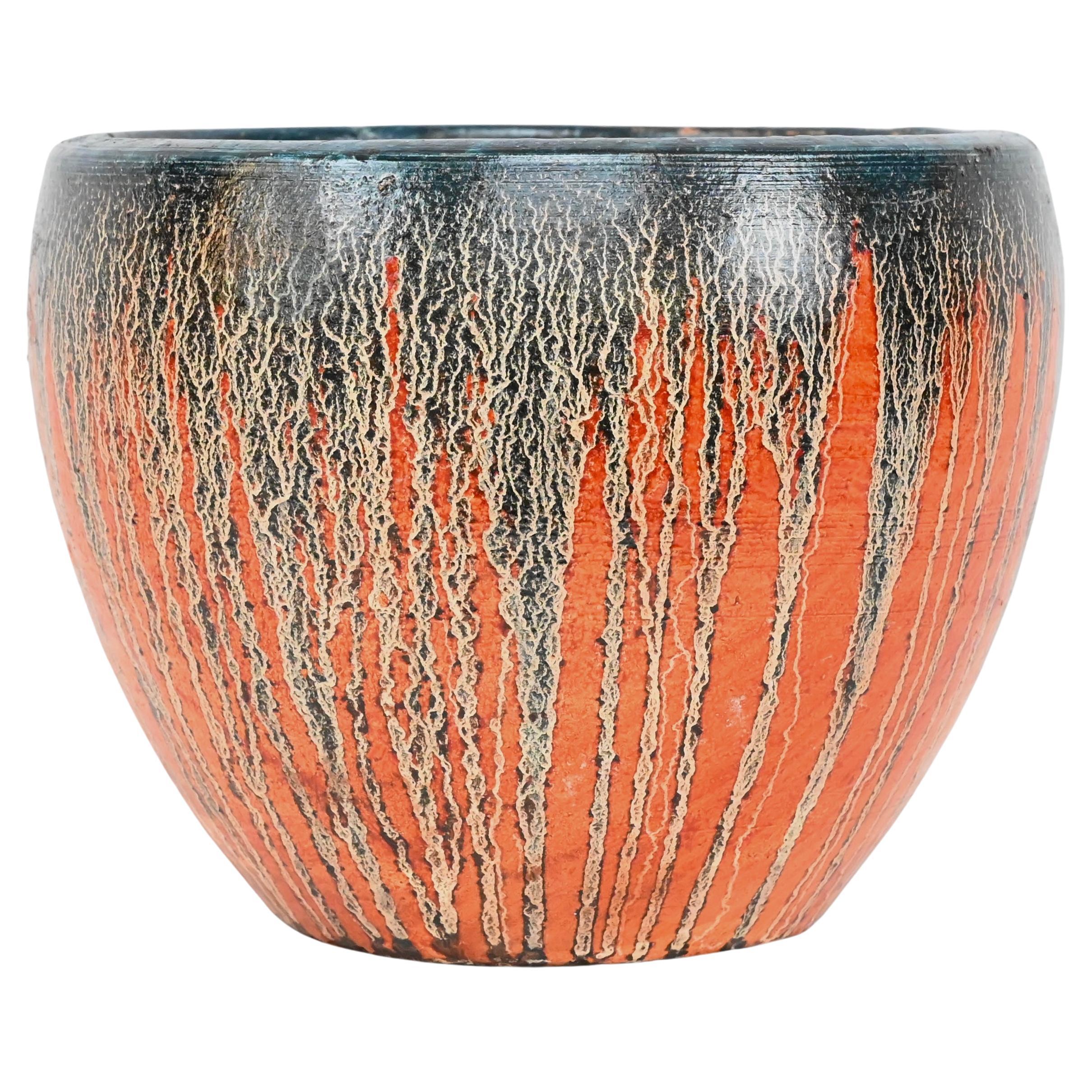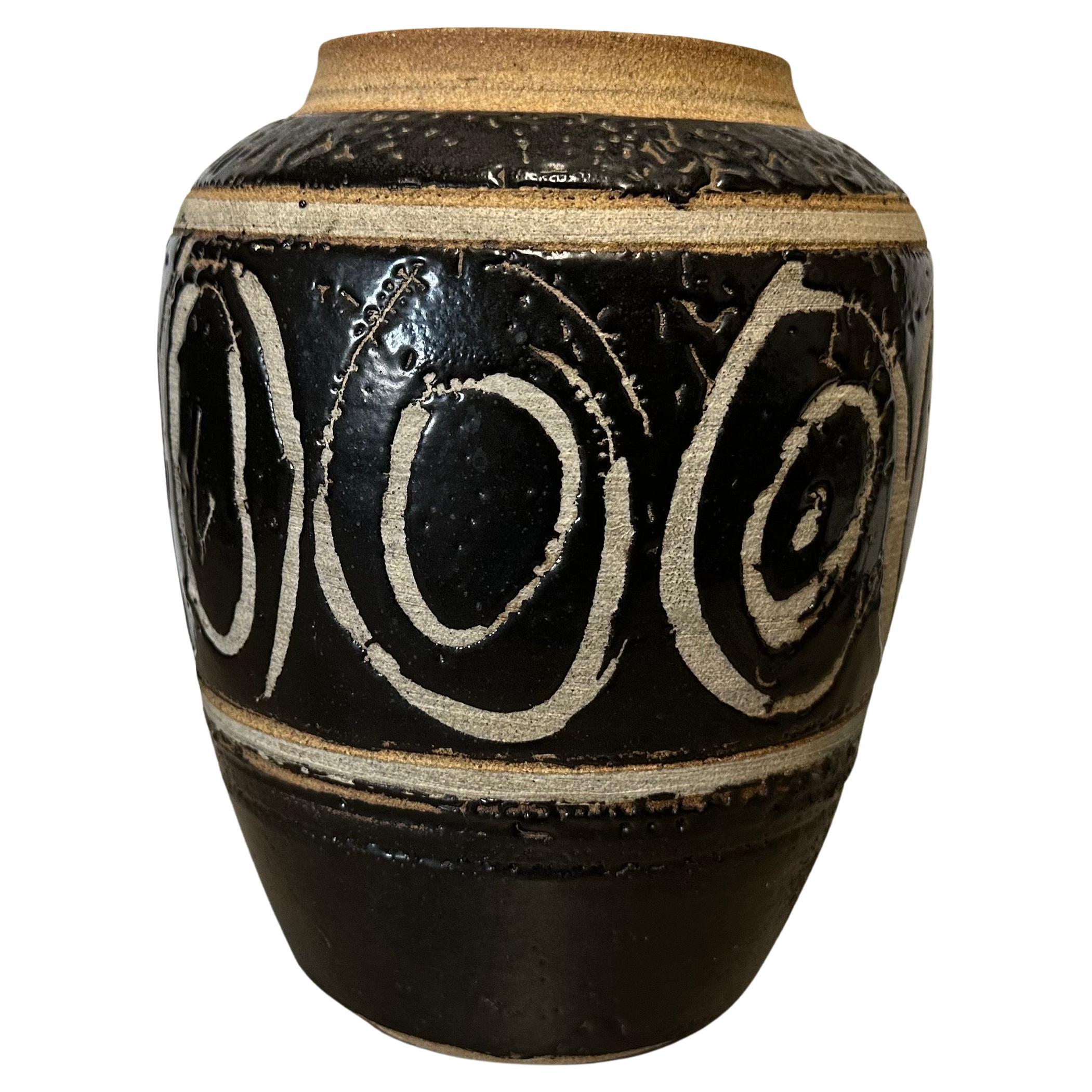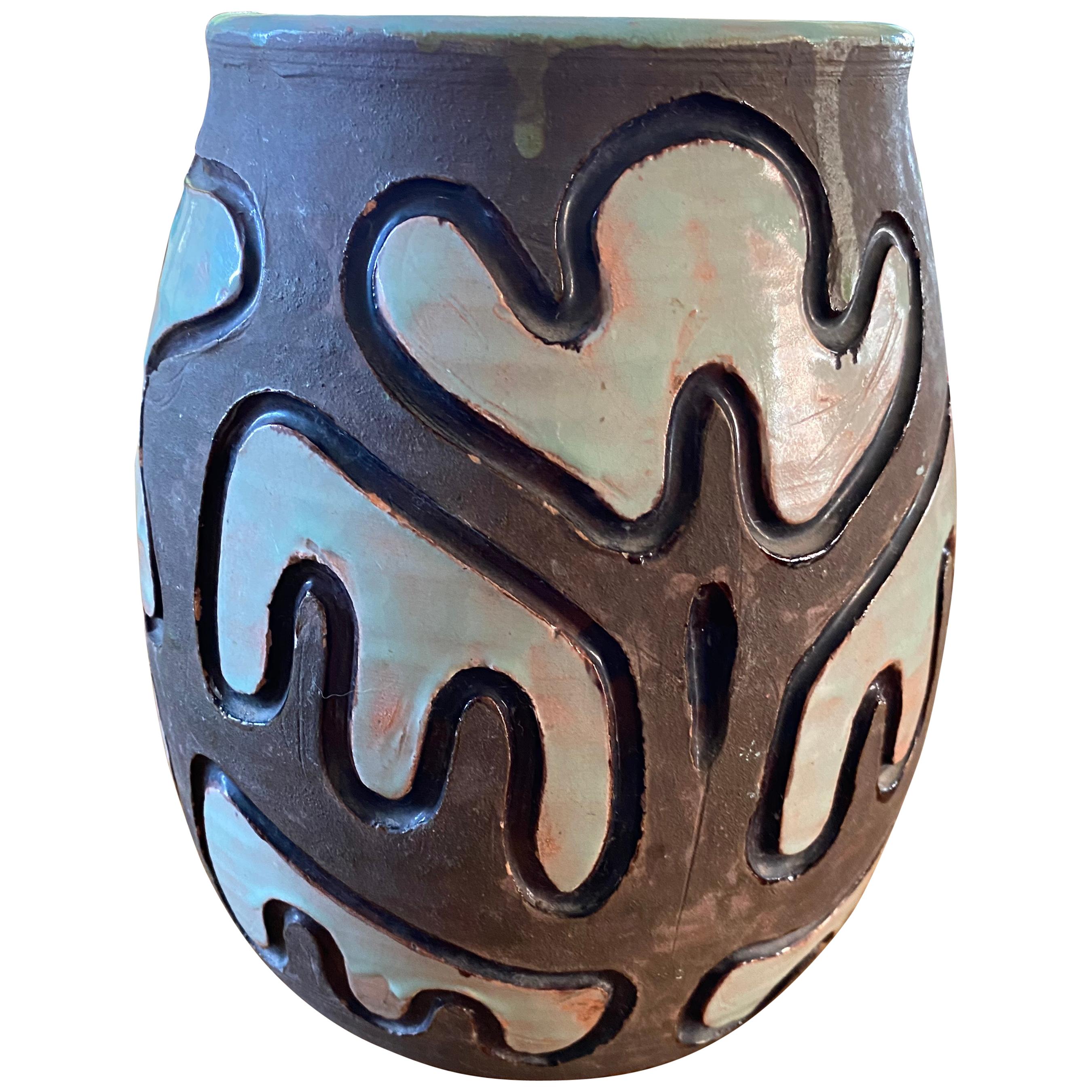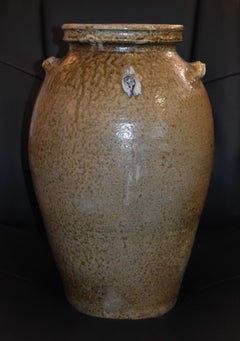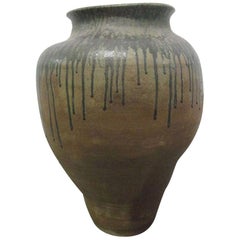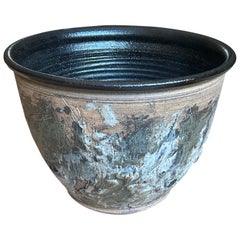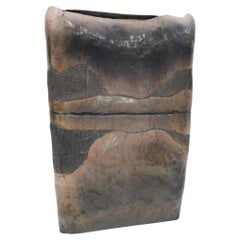Items Similar to Large Sgraffito Planters Mid Century Modern
Want more images or videos?
Request additional images or videos from the seller
1 of 5
UnknownLarge Sgraffito Planters Mid Century Modern1960s
1960s
$4,500
£3,514.86
€3,984.51
CA$6,451.25
A$7,076.67
CHF 3,702.62
MX$84,226.50
NOK 46,766.41
SEK 43,867.73
DKK 29,758.55
About the Item
These are most likely made by Harding Black of one of his fellow local San Antonio Texas potters. They are unsigned but the shape is Harding Black. Regardless they are pretty fantastic Sgraffito planters. Mid Century Modern Planters After Harding Black Circa 1960 San Antonio Made
Image Size: Height 21.25 ''
Frame Size: Diameter 15''
Medium: Glazed Pottery
Circa 1960
Mid Century Modern "Sgraffito" planters
- Creation Year:1960s
- Dimensions:Height: 21.25 in (53.98 cm)Width: 15 in (38.1 cm)Depth: 15 in (38.1 cm)
- Medium:
- Movement & Style:
- Period:
- Condition:
- Gallery Location:San Antonio, TX
- Reference Number:1stDibs: LU76932620233
About the Seller
5.0
Vetted Professional Seller
Every seller passes strict standards for authenticity and reliability
Established in 1974
1stDibs seller since 2017
102 sales on 1stDibs
Typical response time: 1 hour
- ShippingRetrieving quote...Shipping from: San Antonio, TX
- Return Policy
More From This Seller
View AllEXTRA BEAUTIFUL CRACKLE VASE BY MASTER TEXAS GLAZER HARDING BLACK POTTERY
By Harding Black
Located in San Antonio, TX
Harding Black
San Antonio (1912 - 2004)
Huge Heavy Crackle Vase 1985
Height 14''
Across Widest 8"
Biography
Harding Black San Antonio (1912 - 2004)
Harding Black was born on a farm in Nueces County between Ingleside and Aransas Pass and moved with his family to San Antonio in 1916. There he graduated from Brackenridge High School and attended San Antonio Junior College (1929-30). In 1931 Black joined an archaeological expedition to the Big Bend area sponsored by the Witte Memorial Museum. Initially a painter, he was taught by Rudolph Staffel in 1933 to make wheel- thrown pottery and in the same year began to teach children's ceramic classes at the Witte.
Between 1937 and 1939, Black directed ceramic installation in a San Antonio reconstruction project sponsored by the National Youth Administration and the Works Progress Administration art program. In 1955 he retired from teaching and devoted his time to ceramics. Black became a well-known ceramist from his research, innovations, and writings in the field.
Exhibitions: San Antonio Local Artists Annual Exhibition (1939-42, 1945, 1947); Texas General Exhibition (1940 award, 1942, 1948 honorable mention); National Ceramic Annual Exhibition, Syracuse Museum of Art (1947-54); River Art Group, San Antonio (1948-49); National Collection of Fine Arts, Washington D.C. (1951, 1956); Dallas Museum of Fine Arts (1952 one-man); Martin Museum of Art, Baylor University (1991 one-man); San Antonio Museum of Art (1995 retrospective); National Museum of Art, Washington, D.C. (1995); University of Texas at Dallas, Irving (1998 retrospective). Collections: Dallas Museum of Art; Museum of Fine Arts, Houston; San Angelo Museum of Fine Arts; San Antonio Museum of Art; Martin Museum of Art, Baylor University, Waco; National Museum of American Art, Washington D.C.; New Orleans Museum of Art; Everson Museum of Art, Syracuse, new York; Alfred University (New York).
Harding Black resided in San Antonio Texas where he worked as a potter for over 60 years and far as anyone knows he was completely self taught. I find it amazing that anyone could ever accomplish what he did with with no formal training in either ceramics or chemistry. It was a long and prolific journey from the early hand built earthenware pottery to become recognized as a master of glazes. While I feel that his forms often could be better this is more than compensated for by the spectacular glazes he developed. Constant experimentation and his acquired knowledge of chemistry were the foundations for the wonderful glazes that adorn his pottery.
The following quote is from an interview with Rudolf Staffel His copper reds are unbelievably beautiful. Harding was a master of glazes and one of the most generous human beings in the ceramic field that I've known. He had literally a room full of beautifully organized test tiles of all his glazes, and he would just throw the room open to anybody who wanted to rummage through his tiles. All the recipes were there and he shared them with anyone who was interested. It was wonderful to go and visit him. Although accurate records of all test firings were kept for reference it I have been told that it would be difficult to reproduce many of these glazes because of the kiln he built and clays he used. This may not be the case because in a recent phone conversation (4/11/2007) with Peter Pinnell he told me that some of his students had success replicating some glazes using Harding's formulas By concentrating on the bowl and vessel forms Harding remained true to the historical traditions of pottery making.
The magnificent Harding Black journey began in 1932. At that time he joined the Witte Museum Archaeological Society which provided him with access to their collections of Native American pottery. Harding became fascinated by these pollychromed vessels and he began attempting to create hand built pots. He had very little or no success but a life long of working in clay had begun. It was about this time that he met up with Rudolf Staffel and it was from him that Harding learned wheel throwing and developed ideas of how to operate a studio. Harding was given access to working space at the Witte where he built a wheel and in 1933 he was given a position as ceramic instructor. In this position it was his responsibility to establish a ceramics department. The first kiln Harding built was using plans that were obtained from Newcomb College. He scrounged parts from a junkyard which were used in its construction. This project was not totally successful because of problems reaching required temperatures. As usual this did not deter Harding. He seemed to have a wonderful ability to learn from failure and move on.
In the early 1940's Harding began working with formulas for copper red glazes prepared by Arthur Baggs and Edgar Littlefield. This work only added to his interest in Oriental pottery and fostered a desire to rework many old glazes. Being greatly influenced by A Potters Book published in 1940 by Bernard Leach Harding was now on his way seeking to incorporate form, function and surface treatment into a single entity where the whole is greater than the sum of the parts.
In the 1950's Harding left the Witte and built his own studio where he spent the rest of his life creating his wonderful art. The body of his work is a living tribute to the Harding Black lifelong love of ceramics. Along with being a researcher he was also a teacher always willing to share his knowledge with others. He spent his life producing pots and occasionally taking time off to do a bit if fishing. According to Harding Black - Harding Black 11/14/90 "I am one of the lucky ones. When I get up in the morning I can hardly wait to get to work." 1912 Born April 15 near Aransas Pass, Texas 1916 Family moved to San Antonio 1929 Graduated from Breckenridge High School 1929-30 Attended San Antonio Junior College 1931 Joined Archaeological Society of the Witte Museum, San Antonio, and participated in excavations of ancient Basket maker Indian mounds and caves in the Big Bend area of Texas 1933 Taught by Rudolf Staffel to make wheel-thrown pottery. Set tip studio in a streetcar behind Witte Museum and began teaching children’s ceramic classes 1937-39 Appointed Superintendent of Ceramic Installation for N Y A /W P A reconstruction project in San Antonio 1943 Moved from streetcar studio to new facilities in the reconstructed Ruiz House on the grounds of the Witte Museum Began firing to stoneware temperatures 1947-54 Exhibited each year in the annual National Ceramic Exhibition, Syracuse Museum of Art 1951 Exhibited at the National Museum of Art, Washington, DC 1952 Toured ceramic centers throughout the United States 1953 “Opening the Door to Copper-Reds” by Harding Black, published in January issue of Ceramics Monthly “Harding Black Profile” published in February issue of Ceramics Monthly 1954 “Iron Spotted Glazes” by Harding Black, published in February issue of Ceramics Monthly 1955 Built present studio at 8212 Broadway, San Antonio Retired from teaching at the Witte Museum 1956 Exhibited at the National Museum of Art, Washington, DC 1961 “Lava Glazes” by Harding Black, published in October issue of Ceramics Monthly 1964 “Harding Black Texas Potter” by Jean R Lange, published in November issue of Ceramics Monthly 1971 The Meyer Family Master Potters of Texas, co-authored by Harding Black and Georgeanna H Greet 1980 Harding Black’s biographical information entered into the archives of the Smithsonian Institution, Washington, D C 1983 Harding Black traveled throughout China 1984 Awarded Glaze Research Grant by Southwest Craft Center, San Antonio 1985 Solo exhibition at the Southwest Crafts Center 1987 Selected as Artist of the Year by the San Antonio Art League 1988 Incarnate Word College, San Antonio, establishes Harding Black Fund to aid ceramics students 1990 “Harding Black Pottery...
Category
1980s Modern More Art
Materials
Ceramic
JOHN LEOPARD EAST TEXAS 1850-1883 RUSK COUNTY POTTERY STONEWARE HENDERSON TEXAS
Located in San Antonio, TX
John Leopard (1800-1883) Pottery
Rusk County Henderson Texas Pottery (1850-1883)
5 or 6 Gallon Ovoid East Texas Churn
18 inches tall
11 inches at widest point
Utilitarian
John Leopard (1800-1883) Pottery Rusk County Henderson Texas Pottery (1850-1883)
One natural resource found in Rusk County provided an abundance of raw material for the development of industry in the county. When pioneers arrived in Rusk County in the early 1800's, they found a variety of clays suitable for brick making, tiles, statuary and pottery. Pottery making is one of the world's oldest crafts, with examples of pottery traced back as far as the 7th century BC. Amongst the earliest finds are artistic figures, images of people and animals, and household implements including breakers and dishes. Anthropologists often use the techniques and patterns found in ancient burial sites to form an accurate picture of society through the ages. Earthenware (jugs, churns, and vessels of all kinds) made in Rusk County found a ready market. Some of the early potters were Brown, Leopard, Rushton, Prothro and Russell. Many of Henderson's downtown buildings were made from bricks baked in the kiln of the Howard Brothers...
Category
1850s Other Art Style More Art
Materials
Ceramic
"Huge Oxblood Vase" Beautiful from Texas Master Glazer Harding Black
By Harding Black
Located in San Antonio, TX
Harding Black
San Antonio (1912 - 2004)
Huge Heavy Oxblood Vase 1984
Height 17''
At widest 5''
Biography
Harding Black San Antonio (1912 - 2004)
Harding Black was born on a farm in Nueces County between Ingleside and Aransas Pass and moved with his family to San Antonio in 1916. There he graduated from Brackenridge High School and attended San Antonio Junior College (1929-30). In 1931 Black joined an archaeological expedition to the Big Bend area sponsored by the Witte Memorial Museum. Initially a painter, he was taught by Rudolph Staffel in 1933 to make wheel- thrown pottery and in the same year began to teach children's ceramic classes at the Witte.
Between 1937 and 1939, Black directed ceramic installation in a San Antonio reconstruction project sponsored by the National Youth Administration and the Works Progress Administration art program. In 1955 he retired from teaching and devoted his time to ceramics. Black became a well-known ceramist from his research, innovations, and writings in the field.
Exhibitions: San Antonio Local Artists Annual Exhibition (1939-42, 1945, 1947); Texas General Exhibition (1940 award, 1942, 1948 honorable mention); National Ceramic Annual Exhibition, Syracuse Museum of Art (1947-54); River Art Group, San Antonio (1948-49); National Collection of Fine Arts, Washington D.C. (1951, 1956); Dallas Museum of Fine Arts (1952 one-man); Martin Museum of Art, Baylor University (1991 one-man); San Antonio Museum of Art (1995 retrospective); National Museum of Art, Washington, D.C. (1995); University of Texas at Dallas, Irving (1998 retrospective). Collections: Dallas Museum of Art; Museum of Fine Arts, Houston; San Angelo Museum of Fine Arts; San Antonio Museum of Art; Martin Museum of Art, Baylor University, Waco; National Museum of American Art, Washington D.C.; New Orleans Museum of Art; Everson Museum of Art, Syracuse, new York; Alfred University (New York).
Harding Black resided in San Antonio Texas where he worked as a potter for over 60 years and far as anyone knows he was completely self taught. I find it amazing that anyone could ever accomplish what he did with with no formal training in either ceramics or chemistry. It was a long and prolific journey from the early hand built earthenware pottery to become recognized as a master of glazes. While I feel that his forms often could be better this is more than compensated for by the spectacular glazes he developed. Constant experimentation and his acquired knowledge of chemistry were the foundations for the wonderful glazes that adorn his pottery.
The following quote is from an interview with Rudolf Staffel His copper reds are unbelievably beautiful. Harding was a master of glazes and one of the most generous human beings in the ceramic field that I've known. He had literally a room full of beautifully organized test tiles of all his glazes, and he would just throw the room open to anybody who wanted to rummage through his tiles. All the recipes were there and he shared them with anyone who was interested. It was wonderful to go and visit him. Although accurate records of all test firings were kept for reference it I have been told that it would be difficult to reproduce many of these glazes because of the kiln he built and clays he used. This may not be the case because in a recent phone conversation (4/11/2007) with Peter Pinnell he told me that some of his students had success replicating some glazes using Harding's formulas By concentrating on the bowl and vessel forms Harding remained true to the historical traditions of pottery making.
The magnificent Harding Black journey began in 1932. At that time he joined the Witte Museum Archaeological Society which provided him with access to their collections of Native American pottery. Harding became fascinated by these pollychromed vessels and he began attempting to create hand built pots. He had very little or no success but a life long of working in clay had begun. It was about this time that he met up with Rudolf Staffel and it was from him that Harding learned wheel throwing and developed ideas of how to operate a studio. Harding was given access to working space at the Witte where he built a wheel and in 1933 he was given a position as ceramic instructor. In this position it was his responsibility to establish a ceramics department. The first kiln Harding built was using plans that were obtained from Newcomb College. He scrounged parts from a junkyard which were used in its construction. This project was not totally successful because of problems reaching required temperatures. As usual this did not deter Harding. He seemed to have a wonderful ability to learn from failure and move on.
In the early 1940's Harding began working with formulas for copper red glazes prepared by Arthur Baggs and Edgar Littlefield. This work only added to his interest in Oriental pottery and fostered a desire to rework many old glazes. Being greatly influenced by A Potters Book published in 1940 by Bernard Leach Harding was now on his way seeking to incorporate form, function and surface treatment into a single entity where the whole is greater than the sum of the parts.
In the 1950's Harding left the Witte and built his own studio where he spent the rest of his life creating his wonderful art. The body of his work is a living tribute to the Harding Black lifelong love of ceramics. Along with being a researcher he was also a teacher always willing to share his knowledge with others. He spent his life producing pots and occasionally taking time off to do a bit if fishing. According to Harding Black - Harding Black 11/14/90 "I am one of the lucky ones. When I get up in the morning I can hardly wait to get to work." 1912 Born April 15 near Aransas Pass, Texas 1916 Family moved to San Antonio 1929 Graduated from Breckenridge High School 1929-30 Attended San Antonio Junior College 1931 Joined Archaeological Society of the Witte Museum, San Antonio, and participated in excavations of ancient Basket maker Indian mounds and caves in the Big Bend area of Texas 1933 Taught by Rudolf Staffel to make wheel-thrown pottery. Set tip studio in a streetcar behind Witte Museum and began teaching children’s ceramic classes 1937-39 Appointed Superintendent of Ceramic Installation for N Y A /W P A reconstruction project in San Antonio 1943 Moved from streetcar studio to new facilities in the reconstructed Ruiz House on the grounds of the Witte Museum Began firing to stoneware temperatures 1947-54 Exhibited each year in the annual National Ceramic Exhibition, Syracuse Museum of Art 1951 Exhibited at the National Museum of Art, Washington, DC 1952 Toured ceramic centers throughout the United States 1953 “Opening the Door to Copper-Reds” by Harding Black, published in January issue of Ceramics Monthly “Harding Black Profile” published in February issue of Ceramics Monthly 1954 “Iron Spotted Glazes” by Harding Black, published in February issue of Ceramics Monthly 1955 Built present studio at 8212 Broadway, San Antonio Retired from teaching at the Witte Museum 1956 Exhibited at the National Museum of Art, Washington, DC 1961 “Lava Glazes” by Harding Black, published in October issue of Ceramics Monthly 1964 “Harding Black Texas Potter” by Jean R Lange, published in November issue of Ceramics Monthly 1971 The Meyer Family Master Potters of Texas, co-authored by Harding Black and Georgeanna H Greet 1980 Harding Black’s biographical information entered into the archives of the Smithsonian Institution, Washington, D C 1983 Harding Black traveled throughout China 1984 Awarded Glaze Research Grant by Southwest Craft Center, San Antonio 1985 Solo exhibition at the Southwest Crafts Center 1987 Selected as Artist of the Year by the San Antonio Art League 1988 Incarnate Word College, San Antonio, establishes Harding Black Fund to aid ceramics students 1990 “Harding Black Pottery...
Category
1980s Modern More Art
Materials
Ceramic
Large Wood Turned Hackberry Vase. Turned and Dyed. Master Wood Turner Carmie
By Carmie
Located in San Antonio, TX
Carmie (1959-) Large Hackberry Vase, Height 12" Diameter 6''
Bio
Carmie (1959-)
Wood Turner Carmie K. Acosta was born and raised in San Antonio. By day he works as a synthetic organic chemist specializing in steroid synthesis. His foray into wood turning began in the year 2000 when his father passed away. Growing up, he was surrounded by wood working and the associated wood working tools...
Category
2010s Modern More Art
Materials
Wood
Mesquite hollow form vase/bowl. Natural Art Wood Turning
By Carmie
Located in San Antonio, TX
Carmie (Born 1959) Rustic Mesquite Hollow Form Vase/Bowl Height 4.5" Diameter 5''Biography
Bio
Carmie (1959-)
Wood Turner Carmie K. Acosta w...
Category
2010s Modern More Art
Materials
Wood
"NATURAL EDGE MESQUITE BOWL"
By Carmie
Located in San Antonio, TX
Carmie
Born 1958
Natural Edge Mesquite Bowl
8.75" x 7.5"
2" tall
Biography
Carmie Born 1958
Wood Turner Carmie K. Acosta was born and raised in San Antonio. By day he works as a synt...
Category
21st Century and Contemporary Modern More Art
Materials
Wood
You May Also Like
Paul Chaleff Large-Scale Stoneware Planter
Located in New York, NY
Paul Chaleff large-scale stoneware planter. Handmade, sturdy, nice drip-glazed pattern to the body.
Category
20th Century American Mid-Century Modern Planters and Jardinieres
Materials
Stoneware
$6,900 Sale Price
40% Off
California Design Planter with Abstract Expressionist Glaze 1960s
By Raul Coronel
Located in Los Angeles, CA
One-of-a-kind.
Wheel thrown natural stoneware planter.
Hand applied abstract expressionist textured glaze on the outside with black glaze inside.
No chips, cracks or repairs.
No drai...
Category
Mid-20th Century American Mid-Century Modern Planters, Cachepots and Jar...
Materials
Stoneware
Patricia Degener (1924 - 2008) Ceramic Vessel
Located in Dallas, TX
Degener worked in a variety of media - painting, drawing, words - but pottery was her great love. She won numerous awards for her ceramics beginning with the Young Americans competit...
Category
20th Century American Mid-Century Modern Vases
Materials
Ceramic
Mid Century Ceramic Planter Vase
Located in Miami, FL
A very good quality fat lava style midcentury ceramic planter vase.
Eye-catching details and wonderful earth tones makes this ceramic plan...
Category
20th Century French Mid-Century Modern Planters, Cachepots and Jardinières
Materials
Ceramic
Large MCM Studio Pottery Vase - Signed
Located in San Diego, CA
Large MCM studio pottery vase with a volcanic rock finish, circa 1970s. The vase is in very good condition with no chips or cracks and measures approximately 9"H x 7"W; it is signed ...
Category
Mid-20th Century North American Mid-Century Modern Vases
Materials
Stoneware
$400 / item
Ceramic circa 1950, Signed and Located in Lille
Located in Saint-Ouen, FR
Ceramic circa 1950, signed and located in Lille.
Category
Vintage 1950s French Mid-Century Modern Vases
Materials
Ceramic
More Ways To Browse
Mid Century Modern Texas Art
Madison Brimble
Marc Chagall Signed Book
Mario Fernandez
Mario Romero Fernandez
Martha Burkert
Martha Mood Tapestry
Martha Mood
Matt Jordan On Sale
Matthew Russ
Max Ernst Tapestry
Meiji Period Bronze Insect
Mexican Tourist Posters
Michel Ferrand
Michele Quan
Mimi Parent
Mira Stern
Murakami Pillow
